Donald Trump’s economic policies are once again stirring debate as he prepares for what many believe could be his second term as President of the United States. Winning the presidency back with over 73 million votes, inflation was prominently on the minds of Americans, many of whom felt the financial strains from rising prices for everyday goods. Trump is promising relief, yet, as some economists point out, his proposals could ironically reignite the very inflation issues many voters sought to escape.
During his initial term, Trump’s focus on stimulating the economy came with strategies like large tax cuts, extensive tariffs, and tough immigration policies aimed at bolstering American jobs. Economists now warn, based on certain proposals he has resurrected, these same strategies could lead to increased inflation, pushing prices up when Americans can least afford it. According to some estimates, Trump's approach could result in the average American family losing approximately $4,000 annually due to tariffs alone. So much for tax relief and affordable living.
The discussion surrounding Trump’s potential inflationary impacts is underscored by policies involving tariffs, especially on imports from China. His previous administration applied significant tariffs, and among his current proposals is the idea of implementing universal tariffs as high as 20% to even 60% on Chinese goods. Following this logic, as companies importing products face increased costs, they typically pass these expenses onto consumers, resulting in higher prices for everyday items like food and clothing. Philip Daniele, CEO of AutoZone, highlighted this when stating, "If we get tariffs, we will pass those tariff costs back to the consumer." If these proposals advance, prices across the board could balloon just as they did leading up to the election.
Another major concern arises from Trump’s immigration policies, particularly his stance on mass deportations. Such actions could constrict the labor market, particularly affecting industries like construction and agriculture, which rely heavily on immigrant labor. With fewer workers available, companies may have to increase wages to attract the necessary talent. While this might seem beneficial for workers, economists like Wendy Edelberg assert this could aggravate inflation as businesses increase prices to counterbalance those higher wages.
Speaking of wages, data reflects consumers' purchasing power has diminished over the years. Despite the promises of rejuvenation and economic growth, real wages adjusted for inflation have remained stagnant. Those proponents of Trump’s return argue he could reignite economic prosperity, but many citizens know all too well the consequences of policies pitched as lucrative. A significant number still feel the weight of soaring prices for basic necessities, all of which could worsen under renewed tariffs and potential deportation policies.
This brings us to the Fed’s likely response should inflation escalate following Trump's implementations. A rebound would almost guarantee the Federal Reserve would have to reconsider its interest rates, raising them to counteract inflationary pressures and inadvertently increasing borrowing costs—the last thing most Americans want to see post-pandemic. The recent data indicates the potential for rates to increase, which means mortgages, car loans, and credit card debts could become higher burdens.
Interestingly, some observers note the economic strategies employed during Trump's first term failed to yield the type of growth he repeatedly promised. Despite the stock market flourishing, the tangible benefits were diluted for average working families, as evidenced by their increasing struggles with everyday costs. Will anything actually change this time around? Just because the economy soared during Trump’s initial years doesn’t guarantee similar outcomes today. Economists note the economy is inherently unpredictable, often oscillated between growth and downturns.
Indeed, from rising food prices to deteriorated housing affordability, Americans are well aware of the economic struggles they face—struggles worsened by external factors like climate change, which has increasingly impacted food supply chains. Trump’s energy policies, which aim at maximizing fossil fuel extraction, could pose long-term detriments to climate stability, making food supply management even more precarious. Higher spending on essentials is threatening to become the new normal, potentially overshadowing the elusive benefits of his promised economic resurgence.
The voices opposed to Trump's comeback are adamantly vocal. Lines are being drawn as opponents raise the alarm on the probable consequences of revived tariffs and immigration policies on everyday lives. Critics equate Trump’s return and potential policies with tax cuts favoring the wealthy, arguing they fail to benefit the average American family. The rich may reap the rewards of decreased taxes, but many working Americans—those who truly need economic support—might find themselves paying the price through increased costs of living.
It’s clear as Trump resumes his public push, promising to cut taxes for working Americans, skepticism lurks beneath the surface. The reality of previous tax cuts led to hefty savings for the wealthy, and many worry promises of relief won't dismantle existing burdens but rather compound them. Academics and political commentators are urging voters to remain cautious and informed—it appears history has taught us to be wary of promises laden with grandiosity.
The tensions are palpable as Trump rekindles his presidency aspirations amid economic uncertainty. His economic policies, both enticing and concerning, raise considerable questions concerning their effectiveness and impact on inflation. Americans are faced with the hard choice of whether to believe the promises of prosperity or to brace for more economic turbulence. The stakes have never been higher, and the results of upcoming policy decisions will undoubtedly shape the economic future—either for the good, or by reigniting the fires of inflation.



